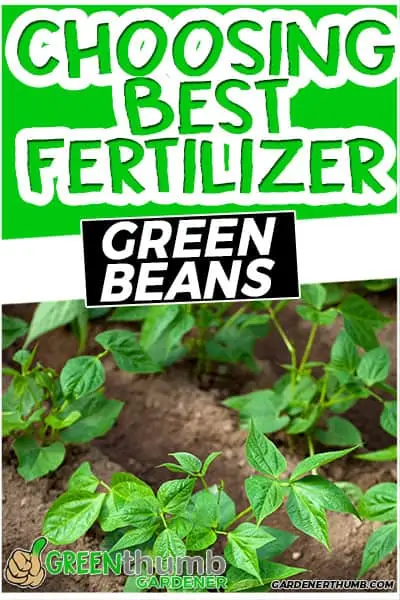Fertilizer for Green Beans Tips
Last updated: 6/8/2022
Green bean plants or string beans are popular among backyard gardeners because they are easy to grow, highly nutritious, and tasty beans.
Fresh beans are high in fiber and protein and low in fat, making for a yummy and healthy meal. Sometimes, I even eat them off the vine while harvesting.
Scarlet runner beans are even beautiful bean plants when they start to bloom.
They are a very cheap and practical way of addressing nutrient deficiencies in people. They grow in warm climates and have two main types of beans: pole beans and bush beans.
We are going to focus on how to grow beans the right way and address the questions of fertilizer application best practices.
Green thumb Gardener occasionally links to product and/or services offered by vendors to assist you with all your gardening needs. Some of these may be affiliate links, meaning we earn a small commission if items are purchased.
Want to Download a Garden Hack Guide for FREE

Enter your email below and we will send you a guide to help you SAVE money in your garden.
What Is The Best Fertilizer For Green Beans?
Green beans do not require too much fertilizer. You can fertilize and apply some organic matter to them at least once a month during the growing season.
Green beans are different from other garden crops because they can produce nitrogen so there is no need to use a Nitrogen-high fertilizer.
It would be better to use low-nitrogen 5-10-10 fertilizer or 6-12-12 fertilizer. You can also use non-chemical organic fertilizers from compost, bone meal, or well-rotted manure.
| Image | Product | Features | Price |
|---|---|---|---|
Best Liquid Fertilizer  | Lilly Miller Fertilizer, 1-Gallon, White |
| Check Current Price |
Solid option  | Master Nursery 5-10-10 Tomato & Vegetable Food, 5 lb |
| Check Current Price |
Best For Root Veggies  | Lilly Miller Morcrop Tomato & Vegetable Food |
| Check Current Price |
Good All Around  | Jobe’s Organics All Purpose Granular Fertilizer |
| Check Current Price |
Understanding Fertilizer Numbers
When buying fertilizer, you would often see numbers on the fertilizer packaging, such as general-purpose fertilizer with 10-10-10 on its packaging, so what do they mean?
The numbers represent the percentage of each component of Nitrogen (N), Phosphorous (P), and Potassium (K) or simply NPK. For example, 6-12-12 will mean 6% of Nitrogen, 12% of Phosphorous, and 12% Potassium.
Commercial fertilizers have different mixtures because plants have different nutrient needs.

Applying A Dressing of Fertilizer
Always make sure you follow the manufacturer’s instructions in applying the fertilizer. Prepare the soil using a spade or tiller before planting and applying the fertilizer.
If you use granular fertilizer, do not place them directly on the plant but the edges a few inches away from it. You have to apply granular fertilizers a few days before planting.
Normally you would need 1 1/2 pounds (0.91 kg) of fertilizer per 100 square feet (9.29 m²) of the garden bed. Afterward, water it well so that the fertilizer is dissolved into the soil and absorbed by the root system.
However, if you are using a water-soluble or liquid fertilizer, always follow the manufacturer’s instructions. Use a hose-end sprayer when using them.
It would be better to use a granular fertilizer at the start of the planting season and, after a month, change to a water-soluble or liquid fertilizer.
What Do You Feed Green Beans Plants?
As previously discussed, green bean plants need a combination of water, compost, commercial fertilizers, and plenty of sunlight to produce an excellent bean crop.
Bush beans will need around 50 to 55 days after planting before harvest, while on the other hand, pole beans will need about 55 to 65 days. Pole beans require a long time because they need more time to grow the bean vines.
Plant diseases and insects are a common threat to green bean plants. Ensure the plants enough space and avoid overcrowding since they encourage the spread of plant diseases.
How to Grow Beans
The planting season for green beans usually starts during spring, after all the spring frost has melted and the danger of frost is gone. Most garden centers won’t sell transplants, but you can easily start them from seed
But you can also do it a few weeks earlier indoors when you initially plant the seeds and grow the plant seedlings. In the fall you can start as early as 9-12 weeks before the expected frost.
The green beans grow very well in organic and well-prepared garden soil.
Sunlight and Water
To optimize their growth, the plants need plenty of sunlight, between 6–8 hours of sunshine. Don’t forget to water your plants at least once or twice a week, especially in dry weather, to maintain a good moisture level.
Green bean plants need only around 1/2 inch (5.08 cm) of water every week. If you don’t water your plants, they will not flower, but make sure you water during sunny days so that they will not get soaked and become prone to plant disease.
It would be better to water the plants early in the morning so the excess water can evaporate during the sunny afternoon.

Remember if the water stays too long on it might encourage the growth of powdery mildew on the pods and leaves.
Moisture is very important so it’s also important to placed layers of mulch on the ground to control the amount of moisture and regulate the temperature. Mulch can easily be created from chopped leaves, grass trimmings, and hay.
Mulch can also help prevent the growth of weeds in your garden.
Planting
Don’t forget to prepare the seeds before planting. Soak them in water overnight. Soaking will help hasten the germination process.
Make sure you don’t place the seeds too deep. Around 3/4 to 1 inch (2.54 cm) deep will be just fine. Spacing between the seeds is crucial, so make sure they are at least 1–2 inches (5.08 cm) apart.
After sprouting, thin them, so they have a 3 to 4 inches (10.16 cm) distance between them. Placed them in rows at least three feet apart.
Weeding and Trimming
Make sure to check for weeds and remove them carefully to not disturb the green beans’ shallow root system.
If your planting pole beans, make sure you pinch off the vines’ top, especially if they already reach the top of their stake support.
Doing so will channel more energy to help create more bean pods.
Proper Soil Preparation For Green Beans
Proper soil preparation is essential to have healthy green beans. Make sure the garden bed is free from weeds and trash. Use a rake to till the garden soil to at least 8 to 10 inches (25.4 cm) to loosen it.
They grow best in well-drained soil and typically need a small quantity of fertilizers. If you think the garden soil does not have enough micronutrients, you can support it with extra fertilizers or compost before planting.
Beans grow best in a slightly acidic to neutral soil that is around 6 to 7 PH level. Do not forget to set up the stakes to support your pole bean plants before they begin growing bean pods.
Dry soil will limit the growth of most bean varieties, so make sure to keep the soil moist, especially during hot days, to keep plants healthy.

Further Reading
Final Thoughts
Green beans are excellent plants because they can grow fast and provide pods rich in fiber and proteins. They are also reasonably easy to grow and require a small space in your garden.
If you follow the proper planting and caring procedures like the ones discussed in this article, you can be assured of a bountiful harvest.
They are also delicious, and mixing with other vegetables will indeed create a very delightful dish.
Related Questions
How can I increase the yield of my green beans?
You can increase your long beans’ yield through proper care, watering, and using fertilizers like compost or other commercial fertilizers.
Is Miracle Grow good for green beans?
If you follow the directions on the label and use it throughout the season, it will help fertilize your plant and the soil.
Is Epsom salt good for green beans?
It can temporarily boost magnesium levels in the soil. However, beans usually grow with the average level of magnesium present in the ground and usually no need to use Epsom salt.








